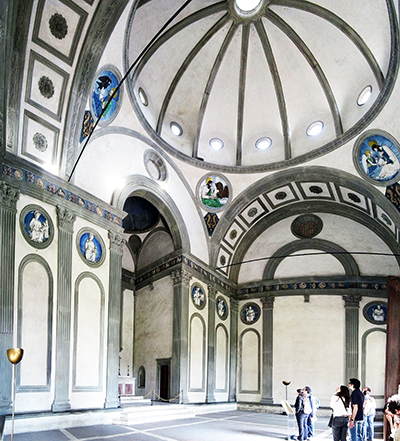Pazzi Chapel was designed and built by Filippo Brunelleschi as a perfect space that has harmonious proportions. He achieved that by including in this project the knowledge that he gained while he was staying in Rome when he was primarily focusing on measuring ancient buildings.
Though funds for the Pazzi chapel were assembled in the year 1429 by Andrea Pazzi, who was head of the family called Pazzi, whose wealth was second to the Medici, construction of the building didn't begin until around 1442. The building is regarded as an Early Renaissance masterpiece. This building's main purpose was the cathedral chapter house, which is a meeting room meant for the governing chapter, plus use as a classroom, specifically for monks teaching and other religious purposes. Also, there was a chapel positioned behind the altar; the commissioning family could bury its dead here.
The ulterior motive of the Pazzi in building this chapel was most likely to attain recognition in Florence city and to emphasise their power and wealth. The fact that Florence was was at war with the neighbouring city during that time and still managed to get the funds to build the chapel showed the importance the building had to the people of Florence and the Pazzi family. Considered as the work of Brunelleschi, it's believed that he was the designer responsible for the plan of this building, which is typically based on the simple geometrical forms, the circle and the square, but not for the execution and detailing of the building. A façade that Brunelleschi had started, and of which the lower register is the only portion that's visible, was partially obscured by adding a porch. The inspiration for that piece was mainly the Santa Maria Novella Dominican monastery, also located in the city of Florence.
The chapel size was predetermined by the existing walls, which created an unusual situation. But where space wasn't square like in the Old Sacristy, this was the model for the building, but rectangular as well as transept-like, hence in contradistinction to the axially-placed altar that's square in shape. Despite that, plus its complex history, this building gives insight into the Renaissance architects ambitions in their struggle on bringing clarity to the architectural language that includes vaults, arches, pilasters and columns. There are roundels, which are common Renaissance decorative motifs, above the pilasters located in the transept. Below them, there are tall, blank, panels that are round-headed. The interior architectural elements are all in serene stone (pietra serena). Also in its construction, the building used bearing masonry, which is concrete blocks or mason units with lime plus man made-adhesives for sticking them together.
When this chapel appeared, there was a new architectural style that was taking place in the city of Florence. Looking at how different this is when compared to a Gothic church, which has irregular, convoluted shapes; the architects who worked on the Pazzi chapel had studied classical architecture and took lessons from the ancient Romans on how to use domes, arches and columns. The architects used these features in creating a rational harmony. Composed, rational and geometric are the new keywords for this splendid architectural style.
Filippo Brunelleschi was among the designers who spent their time in Rome learning about ancient buildings; the Pantheon became Brunelleschi's style. When planning the dome of the Cathedral in Florence, he reproduced its design and used the classical forms he had admired in the City of Rome in the works that he did. Geometric clarity came to be the most distinctive feature of Brunelleschi's style and the interior of the Pazzi Chapel is an example of a perfectly executed harmonic proportion. When entering the Pazzi Chapel, the first thing that people will notice is how perfectly as well as rationally organised the chapel is. The rectangular shape of the building has a central square that is surmounted by the hemispherical dome. The architectural elements of the interior are defined clearly by the use of pietra serena. Also, the dome allows the light to filter through the windows that are positioned along its perimeter, which gives the space measure and elegance. The stone bench running along the walls used to serve as a sitting space for monks.
At the entrance of the building, there is a portico that constitutes the chapel facade. It has 6 Corinthian columns plus a centre that is raised like a triumphal arch. As people walk under it, they will see the elaborate, vivid decoration that's inside the dome that Luca della Robbia created in glazed terracotta. Beneath, there is a roundel, also by Robbia, depicting Saint Andrea, Andrea de’ Pazzi patron saint. The works were not completed during the 1478 Pazzi Conspiracy.
The chapel's decoration has a functional feel. For instance, the roundels, which are among the best creations of Robbia, have their blues standing out against the grey and white of the walls. Brunelleschi designed the ones that are placed at the 4 sides of the dome. Underneath them, there is the Pazzi family coat of arms and 2 dolphins. Brunelleschi decided not put an altarpiece to keep his decoration to a minimum. Also, the apse dome has a simple fresco painting of the sky over the city of Florence.
While the construction work was still in progress, a tragic incident really shocked Florence. This episode went down in history as Pazzi Conspiracy or Congiura dei Pazzi, as the Pazzi family got involved in planning the murder of Lorenzo de' Medic and Giuliano, his brother. It happened on 26 April 1478, when the 2 brothers were attending mass in Cattedrale di Santa Maria del Fiore (Florence Cathedral), and they were attacked by Pazzi supporters with the help of the Pope. This happened because the Pazzi wanted to end the Medici leadership over Florence. They killed Giuliano, but Lorenzo managed to escape; he took a gruesome revenge against them.




